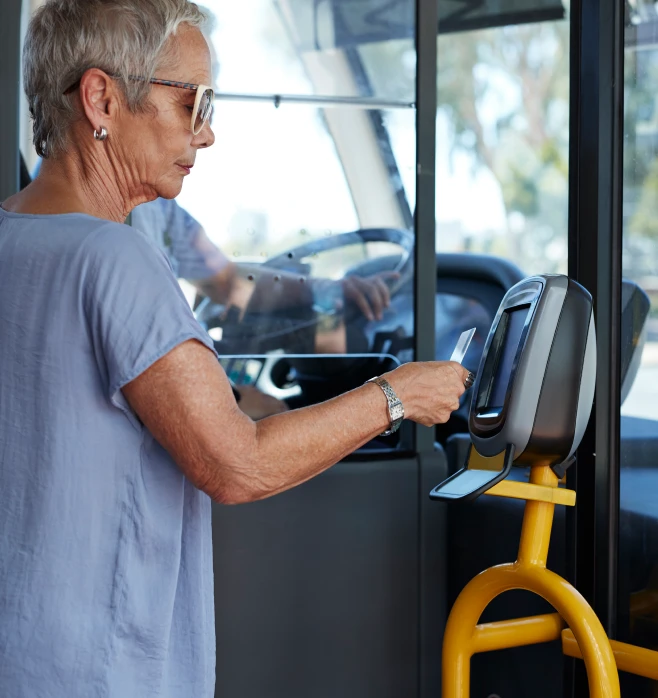
Digital payments in public transportation have become a game changer, transforming how commuters interact with transit systems and how these systems operate. By leveraging cutting-edge technology, transit authorities are offering a seamless user experience (UX) and best fare benefits, making public transportation more accessible, efficient and sustainable.
The Benefits of Digital Payment Systems for Commuters
For commuters, digital payment systems provide numerous benefits:
- Seamless Experience: digital payments offer a streamlined process, eliminating the need of cash or physical tickets. This ease of use translates into shorter queues, quicker boarding and a more pleasant travel experience
- Best Fare Benefits: many digital payment systems automatically calculate the best fare based on travel patterns, ensuring commuters always pay the lowest possible price.
"Digital payments in public transport are fundamental for a new approach to mobility as they provide the best user experience for the final customer,” says Emiliano Doveri, Head of Strategic Partnership, PA & Transit in Nexi. Emiliano underscores the importance of digital payments as a facilitator and innovator in mobility.

Impact on Sustainability
Digital payments significantly contribute to the sustainability of public transportation systems:
- Reduction in Carbon Footprint: digital tickets reduce the need for paper, leading to lower carbon emissions associated with paper production and disposal. The environmental impact of producing physical tickets, including CO2 emissions, is substantial.
- Less Waste: by eliminating physical tickets, digital payments help reduce paper and plastic waste. Key performance indicators (KPIs) can track reductions in waste, underscoring the environmental benefits of digital systems.
“As a game changer, digital payments are taking care of sustainability and digital transition. Digital payments in mobility mean, as a matter of fact, less paper costs and fewer emissions of CO2” declares Emiliano Doveri, Head of Strategic Partnership, PA & Transit in Nexi. This highlights the role of digital payments as a facilitator and innovator in mobility.

Economic and Social Impacts
For public transport operators, the shift to digital payments offers several economic advantages:
- Cost Savings: digital systems reduce the need of printing, secure werehousing and distributing physical tickets, leading to significant cost savings.
- Data Power: digital payments generate valuable data that can be used for marketing, operational planning, and improving overall service efficiency and the best offer for the final customer being perfectly compliant with privacy regulations.
- Marketing and Planning Insights gained from payment data enable targeted marketing campaigns and more accurate planning of services, enhancing operational efficiency and passenger satisfaction.
Improved Accessibility and Convenience
Digital payment systems enhance accessibility and convenience for passengers by:
- Simplifying Transactions: commuters can use a variety of digital platforms to pay for fares, including mobile apps and contactless cards, making public transportation more accessible to a broader audience.
- Real-Time Updates: digital platforms can provide real-time updates and notifications, improving the travel experience and reducing uncertainties. Digital mobility is easy, safe, fast and help a more detailed control of monthly expenses.

Technological and Operational Aspects
Integrating digital payment systems into existing public transportation infrastructures poses several challenges:
- Hardware Costs: the initial investment in new hardware can be substantial. However, these costs are often offset by long-term savings and efficiencies gained through digital systems.
Policy and Future Directions
Looking ahead, digital payments are poised to drive significant changes in public transportation:
- Evolving Mobility Experience: digital payments can serve as a catalyst for broader changes in mobility, including integrated transportation networks that offer seamless connections between different modes of transit and also improving other methods of payments that can be even more sustainable and easy.
Case Studies and Best Practices
Several cities have successfully implemented digital payment systems:
- Naples, Milan, Rome, Bologna and many other cities and some Italian Airports: these cities and transit hubs have adopted digital payments with great success. Key factors include robust infrastructure, user-friendly platforms, and comprehensive marketing campaigns to encourage adoption and to facilitate both national and international mobility. Many projects in other cities are in progress.
User Experience Enhancement
The use of digital payments vastly improves the user experience compared to traditional methods:
- Enhanced UX: digital payments streamline the entire process, from purchasing tickets to boarding and travelling, resulting in a more user-friendly and efficient experience.
Data and Analytics
Data collected from digital payment systems is a valuable asset for improving public transportation services:
- Operational Improvements: analysing payment data helps optimise routes, schedules, and service frequency, enhancing overall efficiency.
- Marketing and Security: data can be used to tailor marketing efforts and enhance security measures, ensuring a safer and more personalised travel experience for passengers.


